Skyrocketing gas prices and V-8 powered behemoths everywhere; an unpopular president trying to bolster flagging support for a war in villages with names no one can pronounce; volatile housing prices in an ever-correcting market; high food and energy prices coupled with the looming threat of runaway inflation hamstringing consumer confidence – it’s the seventies all over again.
For anyone old enough to recall the ‘Me’ Decade, snorting cocaine with a South American supermodel while passionately discussing Kandinsky with Tom Wolfe at the local disco was strictly for the rich and famous. For most Americans, the reality was seeing if you could choke down Hamburger Helper one more night a week to save enough to take the kids to Magic Mountain.
It was also a time of more FUD than one could have thought possible in the pre-internet era. Stories abounded of oil companies sponsoring the assassinations of shadowy cabbies who had figured out how to milk 100 mpg from modified Checker cabs. A similar rumor told of a water-powered engine bought and buried by one of the big three automakers. Suddenly, people everywhere were trying everything from mystery tablets in their gas tanks to chinchilla farms, all in vain attempts to save a buck.
It was with a similar mixture of fiscal fear and trepidation that I began my own potential boondoggle, intended to save a few bucks while ending up with a new guitar when all was said and done. The idea was simple: build a guitar that could make a burgeoning cork-sniffer happy while keeping the checkbook and significant other appeased – happy on all three counts would be too lofty a goal.
For me, the magic number was $1000; an amount I could begrudgingly eat if the guitar ended up being a dud, yet hopefully enough to procure some good bits. A few minutes of forethought and some honest assessment of my woodworking skills limited my choices to Fender-inspired, bolt-on designs; being a Tele fan helped narrow those choices further. To stack the deck, I chose to build an Esquire in order to save a few bucks on a neck pickup that might be used for nicer woods or better components.
Indecision Time
A few minutes spent surfing sites such as Warmoth, USACG and Musikraft made it apparent that I would be foregoing any flame, birdseye or quarter-sawn options. A rattle can finish was also in my future – pre-finished necks and bodies would eat up the budget before getting started. This led to another concern: choosing which company to source the neck and body. In an effort to make things as fair and unbiased as possible, emails were sent out and the first to respond would be chosen – slow servers, overzealous spam filters and vacations be damned.
Scott from Musikraft was the first to respond, so that was sorted. Well, not really. I had to figure out if I was going to remain true to any particular era – blackguard, midfifties whiteguard or a Buck-approved, maple cap-era plank. The choices were limitless. I toyed with the idea of making an affordable, black pickguard on a whiteguard Jeff Beck clone, but homemade body contours surpassed my comfort level while Musikraft’s option exceeded my budget. I decided to look for inspiration elsewhere.
I tried searching for components and found myself quickly overwhelmed. Throughout this process, I had relied on forums such as TDPRI.com, thegearpage.net and the forums at ReRanch. Again, being honest about my skill level, comfort level and the amount of time that I could dedicate to this project, the rave reviews and kudos from various forum members led me to Callaham’s Vintage Guitars and Parts. Perusing their site offered turnkey solutions as well as ideas for just how strictly I would need to adhere to the idea of remaining “vintage.” For instance, their all-inclusive “Vintage T model Esquire Hardware Kit” had an option for slotted screws. As a nod to modern functionality, it also featured a screw-in jack cup (yeah!), compensated brass saddles and a Gatton-esque cutaway on the bottom lip of the bridge plate, all for $387.75 plus $12 shipping. Did I mention the Callaham kit includes everything, including a pre-wired control plate? If you have a nice electronics store around and can source good pots or caps, either locally, online or via eBay, this is an area where time spent scrounging can equal big savings while still allowing for top-notch hardware from makers like Callaham, Glendale or Joe Barden.
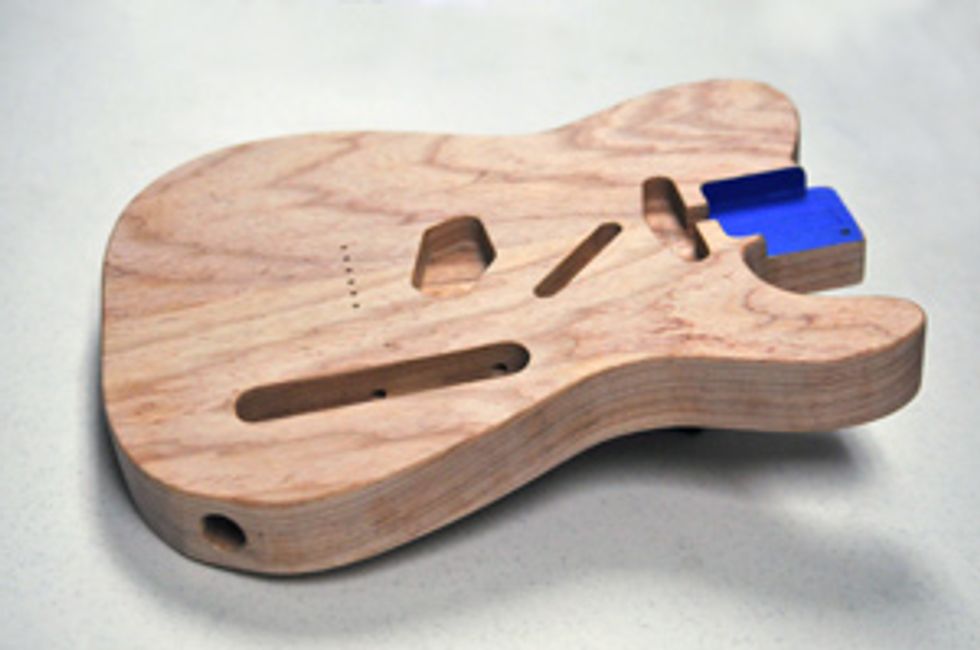
Money, It’s a Crime
I had already decided to use Guitar ReRanch for finishing duties, if for no other reason than to support their excellent tutorials and forums, which also cover using more commonly found finishing supplies, not just their own. I realize there are more economical solutions, but this was my first crack at spraying a finish. Plus, I live in a pretty sparsely populated area – it isn’t like I can just pop down to the shop to pick up Blonde nitrocellulose lacquer whenever I run out. After ordering a can of Butterscotch Blonde lacquer, a can of Fender Neck Amber, two cans of clear nitrocellulose, two cans of Sand and Sealer, a can of oil-based grain filler and a “Fine Grades Sand Paper Pack,” I anxiously awaited for the various shipments to arrive. The damage amounted to $101.10, putting the total at $929.84.
Now I was sweating – my budget was dwindling and I hadn’t decided on a specific pickup. When considering a Jeff Beck vibe, I had looked at Don Mare’s Yardboy- 1, a Harmonic Design ‘54 Special or a Fralin, ranging in price from $80-$125. Since I had changed directions slightly, a blackguard-era pickup design was more in order, so I sent a quick email to Tim Mills from Bare Knuckle pickups and scored a Flat ‘50 bridge pickup. Its £65 price seemed reasonable until I remembered current exchange rates. In greenbacks, the pickup ended up costing $126 plus shipping. I had yet to turn a screw or spackle on any grain filler and I was already over budget. Still, I could try to stay close. Grand total after pickups: $1075.84. I hoped the incidentals would stay to a minimum.
Monica from Callaham won the “most expedient shipper” award, beating everyone by a wide margin, though to be fair, Scott from Musikraft made no bones about needing to manufacture my neck and body and I had no desire to rush him. Opening the box reaffirmed that Callaham was the right choice; all of the parts were carefully packaged and marked. Pulling the pre-wired control plate assembly from the box, I was particularly impressed; all of the soldering was spot-on and every bit of hardware exuded a very high level of quality – the Bakelite pickguard even had the circular spray mark underneath.
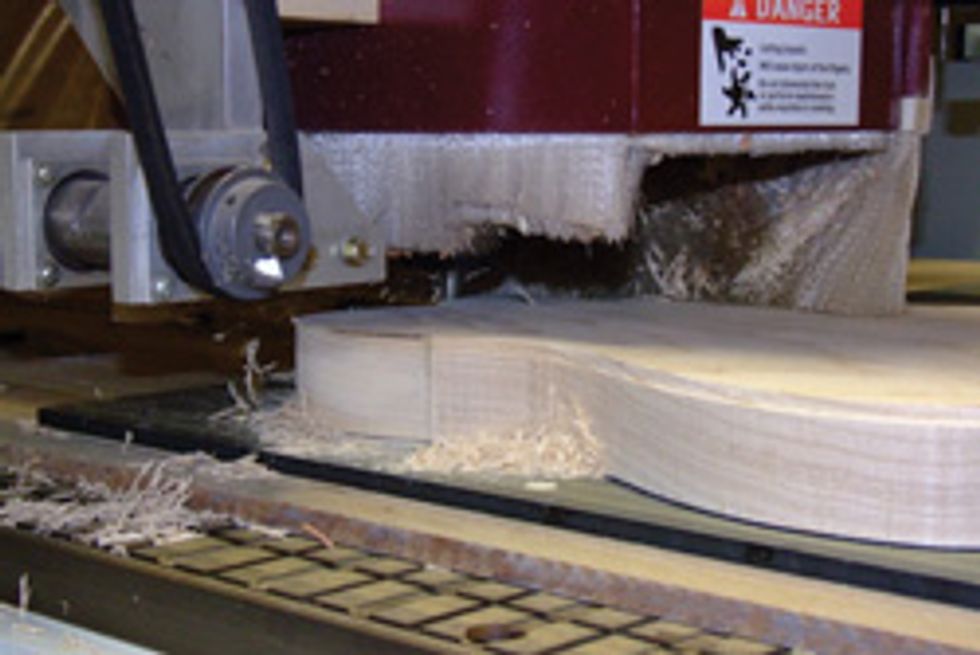 | 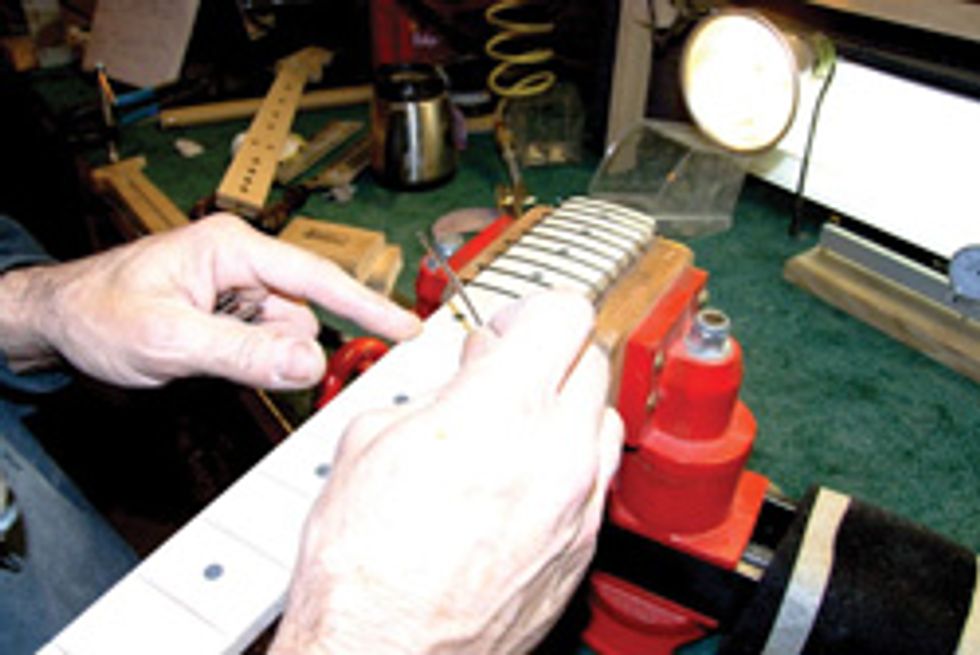 |
| Musikraft kept the anticipation high with in-progress pictures of my body and neck | |
The next highly anticipated package to arrive was from Bare Knuckle pickups, with some added goodies thrown in, namely a set of Rotosounds. Once freed from the foam inserts, my jaw pretty much dropped from the level of craft and workmanship Tim places in his pickups. In fact, I grabbed the Callaham bridge and screwed in the Flat ‘50 pickup just for grins; the resulting combination had the same substantial feel as a really nice watch. A box from ReRanch showed up on one of many of this spring’s stormy days, but everything was well packed and survived the hour or so in the rain. Plus, there would be plenty of drying time while waiting for the neck and body to arrive.
Finally, after being taunted by Scott’s intermittent pictorial updates of my guitar’s progress, a package arrived from Musikraft. Of course, the first thing I did after opening the box was gently place the parts on the unfinished body to get a sense of how it would eventually look. I spent the rest of the evening poring over the tutorials on ReRanch.com, reading through “ReRanch 101,” “Solid Colors, Metallic and Blonde” and “Fender Neck Refinishing” repeatedly, hoping some of it would stick.
I started off the following day by applying grain filler. Luckily, I had recently visited the Hamer workshop and had the good fortune of watching this exact process performed by someone who knows what they’re doing. The trick is knowing when the filler has flashed so the excess can be wiped off without being pulled from the grain. I started by mixing the filler with an errant chopstick, then applied the goo with my fingers. Once it flashed, I wiped across grain to remove the excess with some cheesecloth I picked up at the local hardware store. The next day the body was dry enough to hit with some #220 sandpaper. As with the entire process, good lighting is your friend, as is a jug of mineral spirits – a good wipe-down before sanding can make things easier. The light revealed that I hadn’t done the greatest job, so I slathered on another dollop of grain filler and repeated the process. Once I was happy with the results, it was time to spray some sanding sealer.
Spray and Pray
Applying sanding sealer involves shooting a coat, then after it dries to the touch – ten minutes or so – shooting another coat and letting it dry thoroughly overnight. I set up an impromptu spray area in my garage by hanging a repurposed coat hanger from a staircase. The idea is to build the sanding sealer up, then sand it the following day with some #220 to knock off all of the shiny spots, then repeating the process. According to ReRanch’s instructions, after the second coat, you again knock off all of the shinny spots with #220, then bring it up to #320, repeating the process if there are any sandthroughs. I sanded through on the sides a couple of times, adding a few extra days to this process, too.
| The Difference Between a Coat and a Pass, According to ReRanch: “Perhaps now would be a good time to explain “coat” and “pass.” A pass is just that – one spray pass. A coat is a number of passes, from 1 to ?. In the technique used to develop these pages, a coat is typically three passes. Sometimes two will sufficiently wet out a small area and sometimes four will be used. Five approaches foolhardiness. Six will almost always guarantee a run. “If you are using a gun that is adjustable, a typical setting would be the fan set wide enough to cover about half the area to be sprayed and air pressure at 20 to 30 psi. Liquid feed is set to allow you to wet the area by slowing down the gun’s movement. The setting should lean more to light. A wetter spray setting may force you to move the gun faster to prevent runs. Control the tool – do not let it control you.” |
In the meantime, I started on the neck. ReRanch suggests shooting the tint after the sanding sealer has been applied. Musikraft will ship bare necks, but they strongly suggest purchasing their necks with “sealed wood stabilizer.” I followed their advice when ordering, then called Scott to see what this finish would need. He let me know that it was safe to start as if it was sanding sealer and to just give the neck a quick wipe with naptha before spraying the tint.
Shooting the tint proved to be one of the bigger challenges of this project. Comprised of a dye in solvent, additional coats had a tendency to burn down and cause previous coats to run when sprayed too thickly. ReRanch recommends a light coat of lacquer when you think the color is close to “set” the tint and make sure the shade is to your liking. I did several things wrong with the neck during this process; the first was starting an operation as delicate as shooting tint before I had done much more than spray sanding sealer. Secondly, my work area didn’t have the greatest lighting, making the detection of subtle changes in shade – let alone the depth of the pass – more of a challenge. After a couple of spot repairs, the neck was ready for clear. I decided to set it aside and finish up once I was done with the body since they shared a workspace and I could use the added spraying and sanding experience.
Returning my attention to the body, I began spraying color. ReRanch suggests allowing the grain to be obscured by 50 percent. Shooting a few light practice coats on a scrap piece of wood showed that at that level of opacity the body’s beautiful grain would be too obscured for my liking. I shot a couple of light coats on the body until I achieved the color I wanted – just a touch darker than my Custom Shop Nocaster – while allowing the handsome grain to show through. The Butterscotch Blonde lacquer was deceptively easy to apply; once dry, there were just a few spots of uneven color which were touched up easily enough.
The next step was spraying clear, which happened to coincide with a nasty spill on my motorcycle. The requisite crutches had the potential to jeopardize the project – how would they affect this important step? The answer, in a word, was “positively.” The crutches – along with the pain medication – dictated that I take my time. The result was a less rushed and more thorough finish than if I had normal mobility.
I began spraying the clear per ReRanch’s instructions: spray in a clean, well ventilated area; learn the difference between a coat and a pass (see page 133); keep a tack rag handy; find the right distance away from the wood to get the right coverage; and follow the “rule of threes”: a coat is typically three passes, wait at least three hours between coats and shoot three coats a day, using a tack cloth before each coat. The final three pertains to the minimum amount of days typically needed to shoot a good finish. After drying overnight, the body is then ready for sanding, starting with #400, #600 then finally #800 before starting a new day of spraying. I wish I could say everything went smoothly, but that would be lying. Sand-throughs were all too common; in fact I don’t recall a day of not needing to touch up spots where I sanded through the color coat. While this typically added an extra day to the process, fortunately, I had nothing but time. There are a couple of touched-up sand-throughs where the Blonde is more opaque than I would have preferred, but ultimately, they aren’t that noticeable. To avoid running into the same problem, make sure the lacquer is going on evenly, block sand everything – Styrofoam makes great sanding blocks for wet-sanding – and make sure your sanding area is well-lit. It makes the entire process much easier.
The next hiccup occurred when I ran out of clear. Rather than be prudent and wait for a second order to arrive, I sent my wife down to the local hardware store to pick up some Deft clear lacquer. While I was initially concerned about switching products midway through the project, it seems to have worked out fine. Although ReRanch offers up suggestions on how many cans of “Sand and Sealer” and “Nitrocellulose Clear Coat Aerosol” are typically needed for both body and neck finishing, my experience would indicate halving their estimates for the sanding sealer and doubling them for the clear, although I might be better at sanding through than most. The color estimates seem spot on.
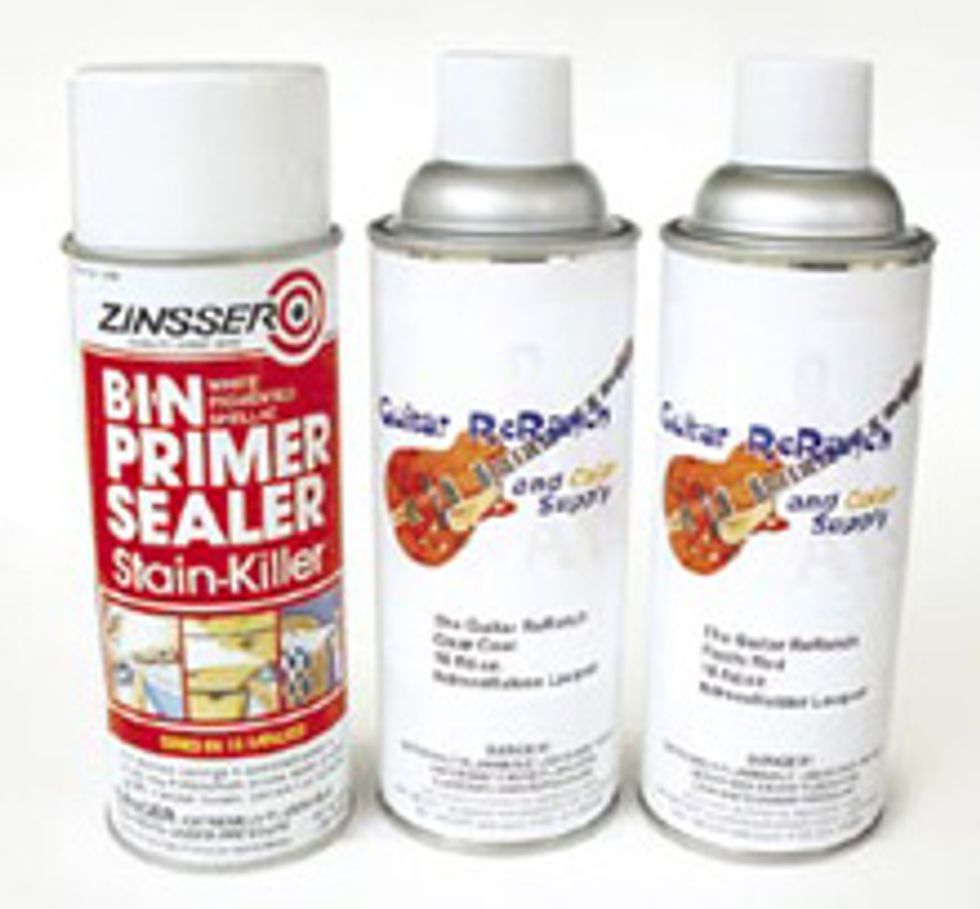 | 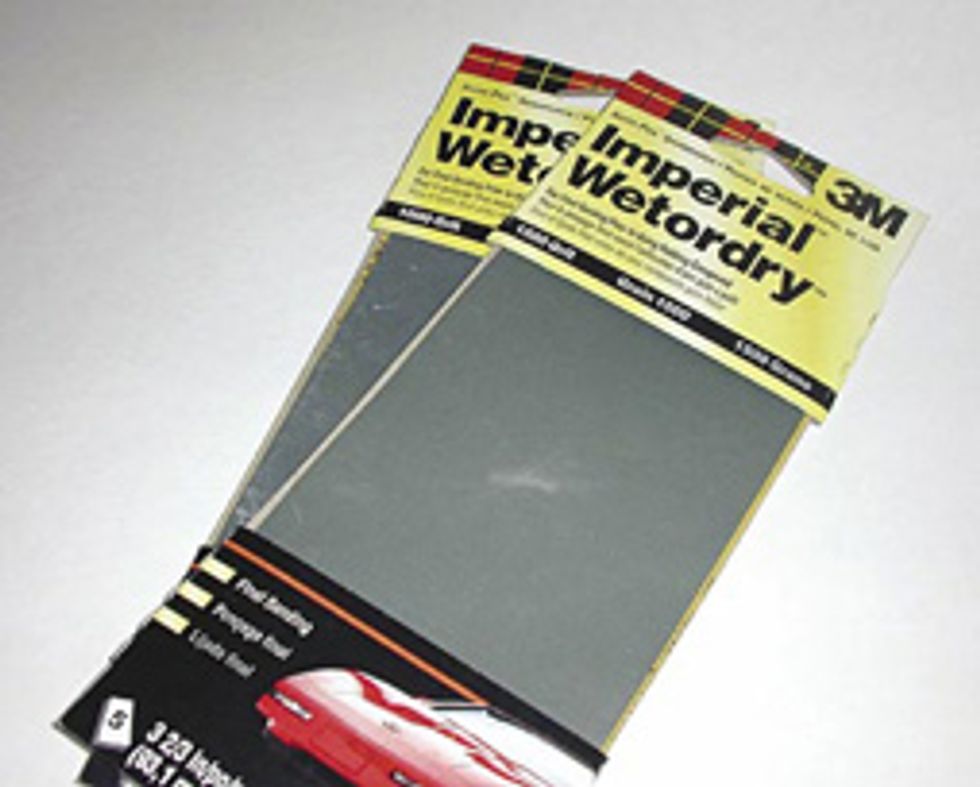 |
After the third day of spraying, the last of the rule of threes comes into play; allowing at least three days of drying after the third and final coat before finish sanding. Since we were continuing to experience an extremely wet spring, I decided to let the body dry for an entire week before beginning final sanding, turning my attention back to the neck.
The clear coats went on easily if not a bit thick. ReRanch suggests not worrying about the frets, instead scraping the lacquer off when the finish is dry. I continued following the rule of threes, and the only tip I have to offer is that a 9V battery worked wonders as a sanding block between the frets (just make sure the battery is drained) and an old Chap Stick container handled the headstock curves well. Did spraying and sanding the neck go more smoothly than the body? Hell no! Sand-throughs were again common and going through the tint was de rigueur. Touching up the tint wasn’t nearly as forgiving as the Butterscotch Blonde had been and it seemed eager to burn through the surrounding lacquer and run at every opportunity. Oddly, even though I sanded out the majority of the neck without a block – a huge no-no – the only spots I sanded through were where a block was used.
In addition to extra days, the sand-throughs resulted in an uneven tint in some spots, but even that has a positive spin – it looks more like a real-deal, vintage neck than the fake-looking, toodark tint on many of Fender’s Vintage series guitars. Although darker than my Nocaster, the project guitar’s neck looks “right,” if maybe a skosh too yellow, but that’s getting nit-picky. Finally, with both enough tint and coats of clear, the neck was hung up next to the body to dry.
Finish Line
The body’s week was up, so I began final sanding. This part of the project involved wet-sanding at each grade from #400 to #2000, then buffing the #2000 grit scratches out with polishing compound. This step went well until I was nearly finished sanding. As finer grades are used – #1000 and up – a shine begins to develop and areas that weren’t sanded well enough earlier become easier to see. To take care of them, you typically back down on the grit number until the sanding scratches disappear, then work your way back up. I was working my way back up from #1200 on a spot on the back when I inadvertently grabbed #600 and used it instead of the desired #1500. Once I realized my mistake, I went back over the area with #800, and by the time I had gotten back to #2000, I had a couple of small sand-throughs. I decided to move ahead and treat them as spot repairs later on.
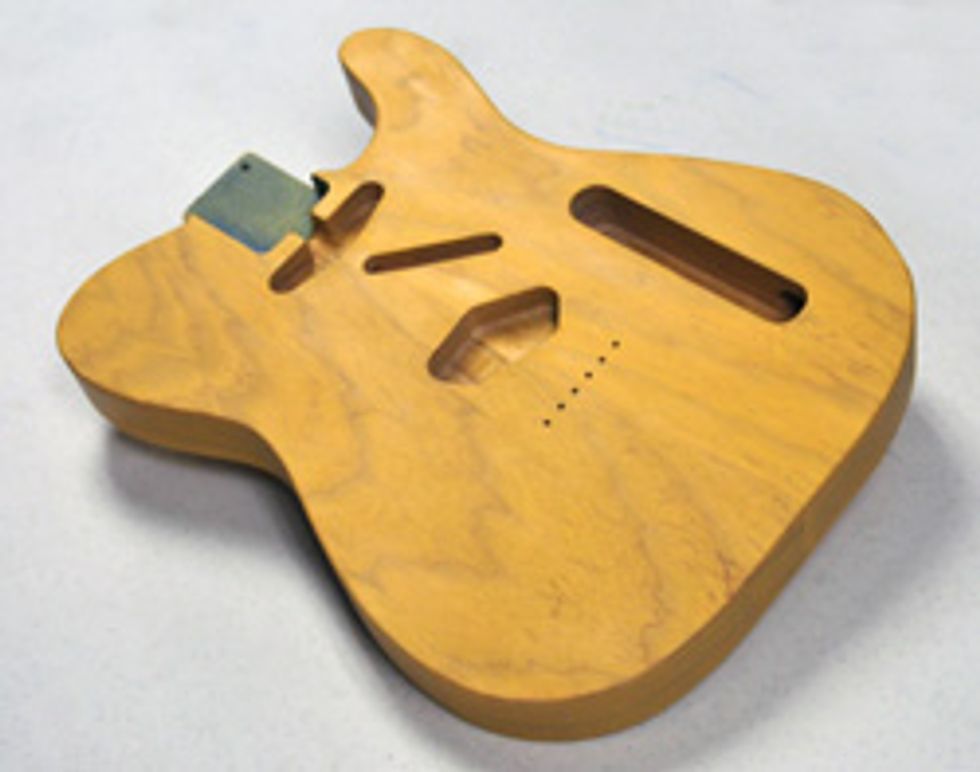
Using an old t-shirt and white compound, I was able to bring up a really nice shine on the body. I was also able to see more spots I missed sanding. I tried using some red compound, but it seemed to add more scratches than it removed. A little apprehensive about returning to sandpaper, I went back over it with white compound and called it a day. All in all, the body turned out much better than I expected, although I question the logic behind choosing a transparent finish as a first attempt – next time it will be Fiesta Red!
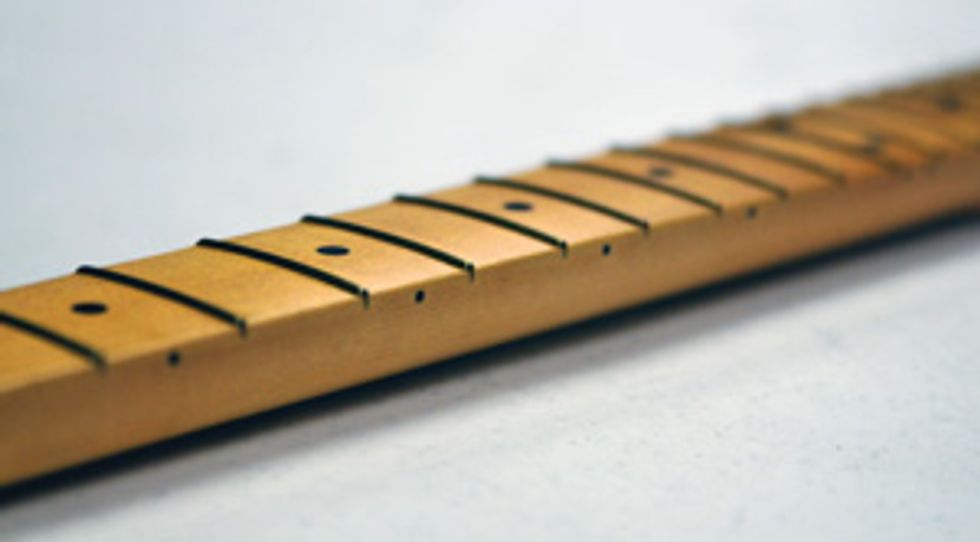
In the meantime, I had another dilemma; should I just totally shine the budget and use this as an excuse to pick up some nut files and a bone blank or take it to my local tech once assembled and kick down the $75 for him to cut a nut? A quick look through the latest Stewart-MacDonald catalog indicated that it would be less expensive – as well as less risky – to let my tech tackle the job. So, not including the additional lacquer from the local hardware store, we’re now looking at $1150.84 before we’ve played a single note.
After allowing some extra drying time for the neck and body, I started putting the guitar together in earnest. Things went together very easily – the string ferrules went in with a satisfying resistance that let me know they were exactly the right size. I used a Fiskers hand drill for all of the screw holes and took my sweet time, keeping the freshly sprayed lacquer happy. Still without a nut, I installed the tuning machines on the neck and placed the bridge using the pre-existing string holes as my guide by sticking toothpicks where the A and B strings would normally pass through. I then bolted up the neck, stuck a folded up piece of paper in the nut slot and loosely strung up both E strings, bringing them up to just enough tension to be used to sight the alignment of the neck and bridge. Laying the pickguard in place indicated that I was in the ballpark, so I drilled the mounting holes for the bridge. It should be noted that the Callaham bridge has two additional screws at the neck side of the bridge, intended to keep microphonic feedback to a minimum as well as transfer additional vibration to the body.
Once the bridge was secured, I placed the pickguard and control panel, moving them around until things looked good before drilling and screwing them down. Honestly, I tried not to be too anal during this process. I’ve seen plenty of old Teles that weren’t too hung up about being symmetrical, which is the same rough-hewn vibe I wanted this one to exude. Because the control plate came pre-soldered, wiring the butterscotch beastie up consisted of soldering a couple of leads from the pickup and the jack to the control plate assembly. I would love to say at this point that I strung it up and rocked harder than anyone has rocked before, but the truth was I still needed a nut. Luckily, my typically overbooked tech had a few immediate openings and I had my guitar back, strung up and ready to go three days and $75 later.
Feels Like the First Time
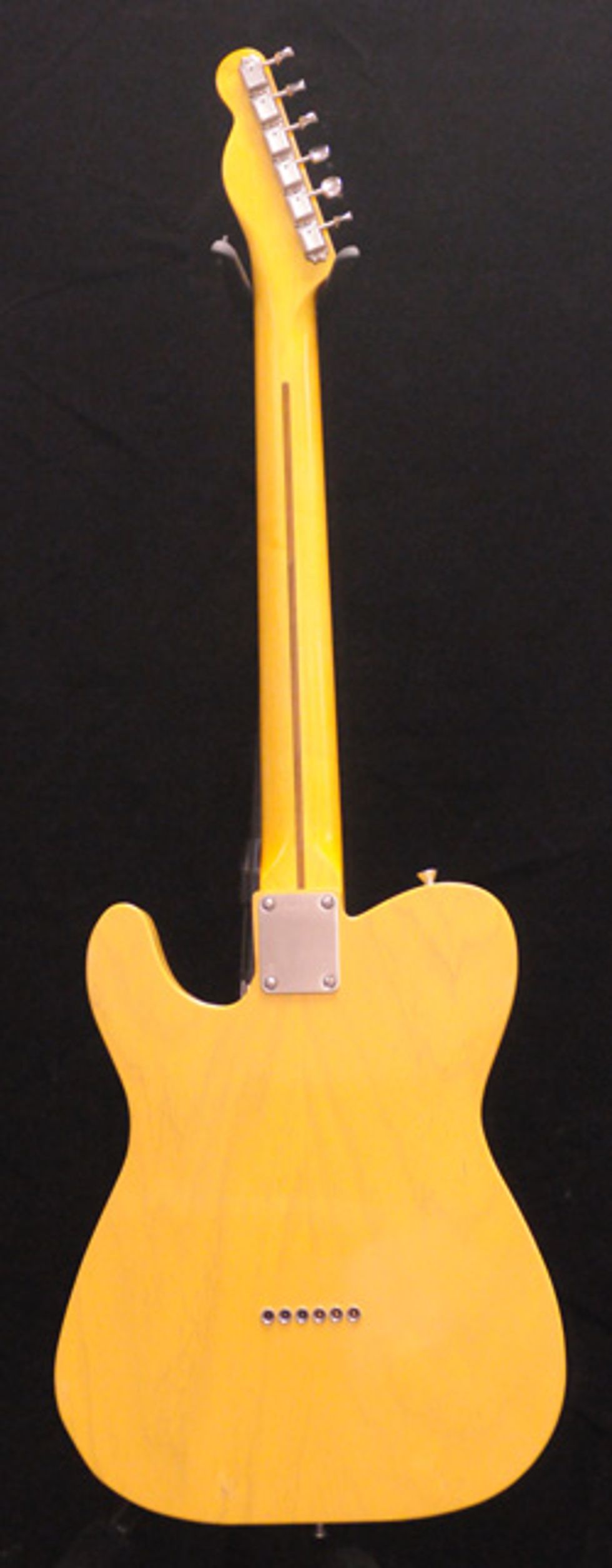
The sound of this particular combination of swamp ash, maple, Callaham hardware and the Bareknuckle Flat ’50 pickup has amazing authenticity and depth, particularly for such a “green” instrument. That’s not to say that the wood wasn’t properly seasoned or anything, just that everything is still settling in – the truss rod required more than the occasional tweak for the first couple of weeks under tension, as expected. The guitar feels nice and light; not stupid light, but more toward the medium side of things. The sound is immediate and typical of a Teletype guitar, but the noticeable tonal difference when switching the tone control in and out of the circuit is quite unexpected. The traditional Esquire wiring provides the pickup with preset capacitor in position 1 for a bass-heavy, “jazz” sound; the pickup with normal volume and tone controls in position 2; and the pickup with the tone circuit bypassed in position 3.
As far as feel and quality, the only thing in my estimation that doesn’t stand up to high-end production instruments is the finish. I can live with the missed sanding scratches and other little gaffes that remind me that I put it together, but they will keep anyone from mistaking this instrument as a Glendale or a DeTemple creation, despite all of the gorgeous wood and high-end Callaham hardware. The finish is also a bit too shiny for my tastes – particularly on the neck, which I’m relatively certain is the direct result of using the Deft. To give you an idea, the guitar looks almost too high-end, not dull enough, like a new Fender Vintage series instrument. While many people would count this as a plus, it makes the guitar look more precious than I had intended. On the plus side, that many sandthroughs means I have a nice thin finish and if the play wear of the past couple of weeks is any indication, it should look nice and worn-in in no time.
However, the biggest surprise has to be how much I enjoy playing it and how well it stacks up to my main-squeeze Nocaster. With the caveat of still being in the honeymoon phase, I’m continually impressed with how nice this thing is every time I pick it up. I wasn’t expecting to like it so much, but then again, why wouldn’t I? It has all of the features I chose. Still, I really didn’t expect it to hold its own as well as it has with the other fine guitars in the house.
The question remains – was it worth it? Let’s be honest and say the guitar cost $1200 when all was said and done, giving us an extra $50 for forgotten trips for sandpaper, sealer glaze and scotch. For that amount of money, you could pick up a new American Deluxe or a used Vintage Series ‘52 Tele, but neither of these choices allows you to spec the instrument exactly as you wish, which is really the whole point of doing something like this.
A potential downside is in the event that you ever need to turn it; its limited resale value is in the parts alone. Unless you are the luckiest person in the world, you will never recoup your investment – if you constantly turn and burn gear on eBay, I hear stamps are a good investment. There is also the chance that you simply won’t like the guitar once it’s finished, again presenting you with a very expensive mistake, no matter the budget.
But, if you’ve been into a specific type of guitar for a while, long enough to know which features you do and don’t like about them, and you have a good idea of what you would ask a custom maker to build for you, building your own guitar makes perfect sense. For instance, I love Teles, but some days even I hate the vintage fretwire on my Nocaster. Also, a homebrew like this is also limited to Jazzmaster, Tele and Strat fans – set-neck and neck-through designs require a skill set light years beyond spraying some lacquer and turning a few screws, with the cost, as well as the opportunity to brick the whole thing, increasing correspondingly.
If I had been able to put this together for under a grand as originally planned, I really don’t think I would like it any more or less than I do now. For me, the magic number to truly affect how I feel about the finished product is $500. If it cost me $1500, I probably wouldn’t love it quite so much – after all, that’s close to the price of a Nash. If it were $500 total, I’d be geeking out on all of the forums, telling anyone who would listen what a killer deal this was. As it stands, I don’t think I could walk into any store and pick up a guitar this nice for $1200 – that alone makes the project worth it. The opportunity it offered to acquire some new, practical knowledge about something I love puts the value over the top.
| Now It’s Your Turn Building your own axe can be daunting; knowing where to start can be downright paralyzing. To help you get started, we’ve assembled a few sources that can narrow down the choices and make sure your first time results a guitar you’ll enjoy for a long, long time. | ||
| Helpful Resources: Telecaster Guitar Forum This site features nuts and bolts discussions of the Tele in addition to plenty of information about component choices, woods and finishes. tdpri.com The Gear Page The definitive spot for any questions about pickups and parts, as well as plenty of information about amps and effects once the project is complete. thegearpage.net Guitar ReRanch Active forums and useful tutorials will guide you to and through most any finish choice. Oh yeah, they sell some pretty cool stuff, too. reranch.com | Bodies, Necks & Hardware At one time or another, nearly everyone has offered parts and we’re bound to leave someone out if we try to offer a definitive list. Instead, we have limited this list to those that are appropriate to a vintage-inspired bolt-on project such as ours. Also note that many companies cross over; for instance, Joe Barden Engineering, renowned for their pickups, also makes bridgeplates and saddles. ALLPARTS allparts.com Callaham Vintage Guitars & Parts callahamguitars.com Glendale Guitars glendaleguitars.com GuitarFetish guitarfetish.com Mighty Mite mightymite.com Musikraft musikraft.com Stewart-MacDonald stewmac.com USA Custom Guitars usacustomguitars.com Warmoth warmoth.com WD Music wdmusic.com | Pickups Again, rather than offer an exhaustive list, here are a few of the makers that offer vintage-flavored Tele pickups. Amalfitano Pickups amalfitanopickups.com Bare Knuckle Pickups bareknucklepickups.co.uk DiMarzio dimarzio.com Don Mare Pickups buckcannon.com Fender fender.com Harmonic Design harmonicdesign.net Joe Barden Engineering joebarden.com Kinman Pickups kinman.com Lindy Fralin Pickups fralinpickups.com Lollar Pickups lollarguitars.com Seymour Duncan seymourduncan.com |







![Rig Rundown: Russian Circles’ Mike Sullivan [2025]](https://www.premierguitar.com/media-library/youtube.jpg?id=62303631&width=1245&height=700&quality=70&coordinates=0%2C0%2C0%2C0)


























